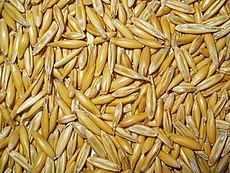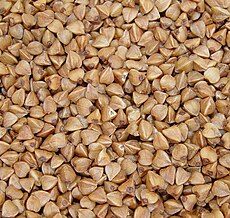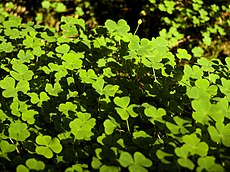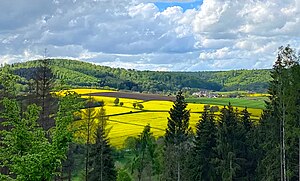Agriculture in Great Kirav: Difference between revisions
m (→Cereals) |
m (→Cattle) |
||
| Line 80: | Line 80: | ||
[[Korlēdan]] is the leading beef-producing state in Great Kirav. In recent years, beef enterprises in Korlēdan have been consolidating under a local affiliate of the [[Federation of Corummese Beef Producers]]. | [[Korlēdan]] is the leading beef-producing state in Great Kirav. In recent years, beef enterprises in Korlēdan have been consolidating under a local affiliate of the [[Federation of Corummese Beef Producers]]. | ||
[[File:Dende a Garita de Erbeira 02.JPG|thumb|'Farrvonian Blonde' cattle in Metrea]] | |||
===Dogs=== | ===Dogs=== | ||
Revision as of 12:40, 16 April 2023

Agriculture in Great Kirav is a major economic activity underpinning local and regional economies across most of the island continent's land area.
As a result of its natural history, the agricultural endowment of the island continent includes both Old World and New World species, and has been supplemented by crops and animals introduced from other continents, such as wheat and cattle.
Even with modern improvements in agronomy, Mainland Kiravian agriculture is insufficiently productive to satisfy enormous domestic demand, and most of the island continent’s food supply is imported, mainly from Levantia, Sarpedon, and South Crona.
Agriculture in Æonara and in other parts of the Kiravian Federacy and Collectivity, such as Sydona, are covered separately.
Crops
Potato

The potato (Coscivian: ēln) is the most important food crop in Great Kirav, and has been since the dawn of agriculture. Potato began to be domesticated as early as 25,000 years ago in the central latitudes of the Western Highlands. The potato plant's remarkable ability to thrive in cool climates and subprime soil conditions made it indispensible to early Kiravian farmers and an enduring staple of the Kiravian diet. Potato is grown throughout Great Kirav, but more so in the north and west. It is the dominant crop in the more marginal lands that make up much of the continent.
Cereals
 |
 |
 |
The principal grain crops grown in Great Kirav are the Three Reliables: Rye and wildrye, Coscivian cuckwheat, and oats, along with barley, wheat, and triticale.
Coscivian cultures conflate two distinct cereal grasses - Secale cereale or "true rye" and Elymus borealis or "wildrye" - under the label of "rye" (Kiravic: dralm, South Coscivian: drallion). Numerous cultivars of Elymus borealis have been cultivated in different regions and microclimatic zones of Great Kirav for centuries. True rye was most likely introduced from what is now Faneria during the Second Empire. Kiravian farmers were early adopters of triticale, production of which continues to expand in traditionally rye-growing areas.
The best farmland, much of which is concentrated in South Kirav and the warmer latitudes of the Baylands and Farravonia, is dedicated mainly to wheat, barley, and (increasingly) maize. Hard red winter wheat is grown in drier mesotemperate areas of the interior, while durum wheat and other varieties are grown mainly in the South. Buckwheat and rye predominate in the middle latitudes, while oats and patricularly hardy wildrye cultivars are grown in the hemiboreal and boreal zones, as well as the mountain vales of the Northwest.
Root Vegetables
Hops
Hops are mainly grown in areas with an oceanic climate. Major hop-growing regions include the West Coast, South, and parts of the Eastern Highlands and Central Uplands. Kiravian hops supply the Kiravian brewing industry and are also exported.
Pre-mechanisation hop cultivation relied on a large seasonal labour force that migrated annually between hop-producing areas and areas of off-season employment. These workers came to regard themselves as distinct social groups known as the hop clans.
Fruit
Feed and Forage
 |
 |
 |
Oilcrops

Other Crops
Other important agricultural products include:
- Allium: Onion, garlic, scallion, shallot, leek, and chives
- Starch crops: Mountain vine, Crisp potato, Kirish moss
- Thanksgiving shit: Pumpkins, gourds, squash
- Deez Nuts: Hazelnut, Shagnut, Chestnut
Stock

Kiravians rear animals for meat, milk, hide, horn, and other valuable products, such as insulin. Wool, from camelids and sheep alike, is a top agricultural export.
Many lowland pastoral regions of Great Kirav, such as Venèra and Axólega, are characterised by a bocage landscape in which parcels of land are separated by dense (and often very old) hedgerows and wooded berms to facilitate herd management and protect crop fields from grazing livestock. In other regions, such as Vôtaska and Elegia, silvopasture is the norm. Open rangeland grazing is most common in Korlēdan, Îkodha, Enscirya, and the South.
Also sheep.
Swine
Cattle
The first attempt to introduce cattle to inland Kirav was made in 25XD4+2Q CC by Oranibur Kaisthev, chancellor to the King of the Antarans. Kaisthev purchased some 400 head of Urcean longhorn cattle to increase the king’s revenues from montane pasturelands. However, upon their delivery to what is now County Upśur in Verakośa, the cattle were immediately slaughtered by terrified locals, who recognised them as the Devil’s hounds. Subsequent attempts were foiled along the same lines.
Korlēdan is the leading beef-producing state in Great Kirav. In recent years, beef enterprises in Korlēdan have been consolidating under a local affiliate of the Federation of Corummese Beef Producers.

Dogs
A pygmy dog breed known in Ænglish as the Kirish game hound is raised for meat, mainly in the interior and parts of the Baylands. Dogmeat was historically regarded as poor man's fare, but has recently undergone something of a lobster effect and become fashionable among the élite. Consumption of dogmeat was on the decline for much of the modern era, but rapidly expanded during the latter half of the Kirosocialist period due to food scarcity caused by the command economy. As dogs were outside the scope of government planning and not regulated as livestock, they could be raised for sale on the black market without fear of criminal penalty. Contemporary production is mainly for the domestic market, due to low foreign demand and legal prohibitions in many countries.
Economics
Landholding, Enterprise Types, and Labour Relations
Policy
Like many temperate industrialised countries, the Kiravian Federacy generously subsidizes its agricultural sector. Federal subsidies to agriculture in Great Kirav (both the Federation and the South) and Æonara are consolidated under a series of Triennial Agriculture Acts and administered by the Agricultural Executive. The federal subsidy programme covers all of the major food staples and cash crops discussed at length in this article; additional subsidies are extended by provincial governments, and often cover smaller-volume crops, emerging products, and regional specialties with a more limited geographic footprint. In addition to protection of the domestic agricultural sector, the Triennial Agricultural Acts address adjacent policy concerns, such as erosion and runoff mitigation, biosecurity, and the preservation of agricultural heritage. The Agricultural Executive also administers the Agricultural Reform Fund, which disburses payments to large landowners dispossessed by the Kiravian Union.
Markets
Agricultural futures and options are traded on several domestic exchanges. Exchanges whose soft-commodity contracts specify delivery points in Great Kirav are as follows:
- Escarda Grand Exchange - Potato, rye, elymus, cuckwheat, oats, triticale, feed clover, canola, milk, lean hogs, frozen pork bellies, broiler chickens, beet sugar, maple sugar,
- Silverda Mercantile Exchange - Potato, hops, crisp potato, Kirish seamoss starch, mountain vine starch,
- Primóra House of Trade' - Barley, hops, wheat, kalir
- Xéulev Hall of Onions - Onions, leeks, cuckwheat, poultry preparations